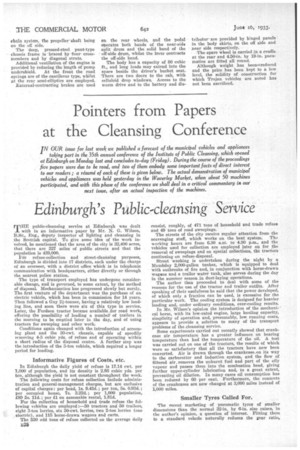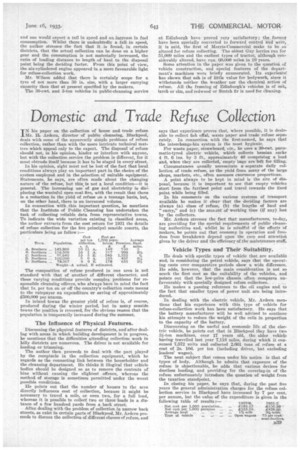Pointers from Papers at the Cleansing Conference
Page 56

Page 57

If you've noticed an error in this article please click here to report it so we can fix it.
IN OUR issue for last week we published a forecast of the municipal vehicles and appliances taking part in the 35th annual conference of the Institute of Public Cleansing, which opened at Edinburgh on Monday last and concludes to-day (Friday). During the course of the proceedings Jive papers were due to be read, and two of them embody some important facts of direct interest to our readers ; a resume of each of these is given below. The actual demonstration of municipal vehicles and appliances was held yesterday in the Waverley Market, when about 50 machines participated, and with this phase of the conference we shall deal in a critical commentary in our next issue, after an actual inspection of the machines.
Edinburgh's Public-cleansing Service T"E public-cleansing service at Edinburgh was dealt with in an informative paper by Mr. N. G. Wilson, B.Sc., Eng., deputy inspector of lighting and cleansing in the Scottish capital. To give some idea of the work involved, he mentioned that the area of the city is 32,400 acres, that there are 327 miles of public streets and that the population is 439,000.
Fdr refuse-collection and street-cleansing purposes, Edinburgh is divided into 17 districts, each under the charge of an overseer, with a district office which is in telephonic communication with headquarters, either directly or through the nearest police station.
The type of transport employed has undergone considerable change, and is governed, to some extent, by the method of disposal. Mechanization bas progressed slowly but surely. The first venture of the department was the purchase of an electric vehicle, which has been in commission for 14 years. Then followed a Guy 21-tonner, having a relatively low loading line, and soon there were six of this type in service. Later, the Fordson tractor became available for road work, offering the possibility of loading a number of trailers in the morning to be emptied later in the day, and of using tractors for sweeping and other work.
Conditions again changed with the introduction of screening plant and the 30-cwt. chassis, capable of speedily rtmoving 4-5 cubic yds. of refuse and of operating within a short radius of the disposal centre. A. further step was the introduction of the :3-ton vehicle, which required a longer period for loading.
Informative Figures of Costs, etc.
In Edinburgh the daily yield of refuse is 17.14 cwt. per 1,000 of population, and its density is 2.86 cubic yds. per ton, although the yield is not constant throughout the week.
The following costs for refuse collection include administration and general-management charges, but are exclusive of capital charges: per head, 1s. 9.43d.; per ton, 5s. 0.93d.; per occupied house, 7s. 3.22d.; per 1,000 population, £81) 5s. 11d. ; per Li on assessable rental, 1.81d.
For the collection of household and trade refuse the following vehicles are employed :-30 tractors and 50 trailers, eight 3-ton lorries, six 30-cwt, lorries, two 2-ton lorries (one electric), and 115 horse-drawn wagons and carts.
The 520 odd tons of refuse collected on the average daily L38 consist, roughly, of 471 tons of household and trade refuse and 49 tons of road sweepings.
The streets of the city receive regular attention from the scavenging staff, which works on the beat system. The working hours are from 6.30 a.m. to 4.30 p.m., and the vehicles used for collection are employed later on for the removal of sweepings and on special collections, the tractors continuing on refuse-disposal. Street washing is undertaken during the night by a l■landslay 2,000-gallon tanker, which is equipped to deal with outbreaks of fire and, in conjunction with horse-drawn wagens and a trailer water tank, also serves during the day in the summer season in dust-laying operations.
The author then proceeded to deal with some of the reasons for the use of the tractor and trailer outfits. After speaking of their usefulness he said that the power developed, of which only a fraction can be used, is excessive for the particular work. The cooling system is designed for heavier loading and, under ordinary conditions, over-cooling results. In Mr. Wilson's opinion the introduction of the mechani-• cal horse, with its low-rated engine, large hauling capacity, simplicity of operation and, presumably, low running costs, appears to provide a solution to many of the transport problems of the cleansing service. Some experiments carried out recently showed that crankcase air temperature has a greater influence on bearing temperature than had the temperature of the oil. A test was carried out on one of the tractors, the results of which were so satisfactory that all the tractors have now been converted. Air is drawn through the crankcase on its way to the carburetter and induction system, and the flow of filtered air, removes the unburnt fuel and part of the oily vapour and passes them into the combustion head, giving further upper-cylinder lubrication and, to a great extent, preventing oil dilution. In many cases oil consumption has been reduced by 60 per cent. Furthermore, the contents of the crankcases are now changed at 3,000 miles instead of 1,000 miles.
Smaller Tyres Called For.
The recent marketing of pneumatic tyres of smaller dimensions than the normal 32-in. by 6-in, size raises, in the author's opinion, a question of interest. Fitting them to a standard vehicle naturally reduces the gear ratio,
and one would expect a tall in speed and ea ifitcrease in fuel consumption. Whilst there is undoubtedly a fall-in speed, the author stresses the fact that it is found, in certain districts, that the actual collection can be done on a higher gear and the consumption is not materially increased, the ratio of loading distance to length of haul to the disposal point being the deciding factor. From this point of view, the six-cylindered engine appeared in a more favourable light for refuse-collection work.
Mr. Wilson added that there is certainly scope for a tyre of not more than 30 in. size, with a larger carrying capacity than that at present specified by the makers.
The 30-cwt. and 3-ton vehicles in public-cleansing service
at Edinburgh have Droved very satisfactory ; the. former have been specially eouverted to forward control and were it is said, the first of Morris-Commercial. Make to be si altered for refuse collecting. The oldest Guy lorries ran for 51,000 miles and the earliest types of tractor, although considerably altered, have ran. 60,000 miles in 10 years. Some attention in the paper was given to the question of vehicle construction, and special features of the department's machines were briefly enumerated. Its experience" has shown that ash is of little value for bodywork, since it withstands neither the -Weather nor the chemical action of refuse. All the framing of Edinburgh's vehicles is of oak, larch or elm, and redwood or Scotch fir is used for cleaning.






































































































